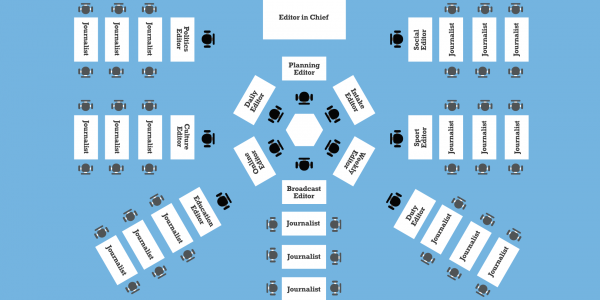Superdesk wants to be your newsroom's digital twin

"What we observe is not nature itself, but nature exposed to our method of questioning." Werner Heisenberg
Micz Flor, co-founder of Sourcefabric, and inventor of various projects for media including LowLive (which begat Campcaster which begat Airtime) and Docmint (Booktype before Booktype existed!) began Day Three of Sourcecamp with philosophy.
Our intention to develop Superdesk was announced in November last year and received huge attention from journalists, NGO's and media worldwide. However, working with a global team can often mean that - for such a huge undertaking - it's tough to understand the bigger picture.
So, what is Superdesk? Our own site tells me that "Superdesk is an open source newsroom tool that ensures media organisations are free to define their own type of newsroom organisation, content delivery and business strategy. It has been built by journalists, for journalists, with the aim of helping the media business towards financial sustainability."
Micz's presentation highlighted the idea that everyone on the team who is working on Superdesk, makes of it what they want. The communications department sees a digital workflow tool, the Cluj developers see a framework for the rapid development of news apps.
So really, Micz continued, the question we should ask is 'what is a newsroom?'
Many things in news haven't changed - take a look at any picture of a 1950's newsroom. There are rows of people at writing terminals with communications device and tables and lamps. However, this needs to be broken down.
"The desks in the newsroom represent roles," said Micz, "and the way they are positioned represent workflows." David Brewer, of Media Helping Media, is one of the key consultants and strategists for Superdesk's developments. He's worked with Al Jazeera, the BBC, CNN and ITV, and his views on newsroom architecture are very clear.
"All senior editorial staff," says David, "need to sit together… in the middle of the newsroom. Around it the editors responsible for the daily output should sit as well as the planning editor and - if resources allow - an intake editor." So, the physical architecture of desks in the newsroom is important, but once broken down, very simple.
One of the easiest ways to therefore look at the bigger picture of Superdesk is to imagine that every conceivable desk in the newsroom has a digital twin assisting the work of the journalists. Some desks in Superdesk handle productivity of the team, some desks move and manage content. Thompson Reuters break down the areas of a newsroom into five areas, and Superdesk will cover all aspects of this.
1. Planning and Assignment
2. Information Gathering
3. Verification
4. Dissemination
5. Archiving
Superdesk's development has begun already with Print Desk, Live Desk, Feed Desk and Citizen Desk. The Ally-Py framework is in place to allow rapid development. As yet though, it's future impact is unknown, but it's something David Brewer is confident about. "It's a dream come true for me. Superdesk could become the publication tool of choice for all who want to deliver content to multiple devices and a massive boost to the establishing of an alternative voice where independent media is absent."
